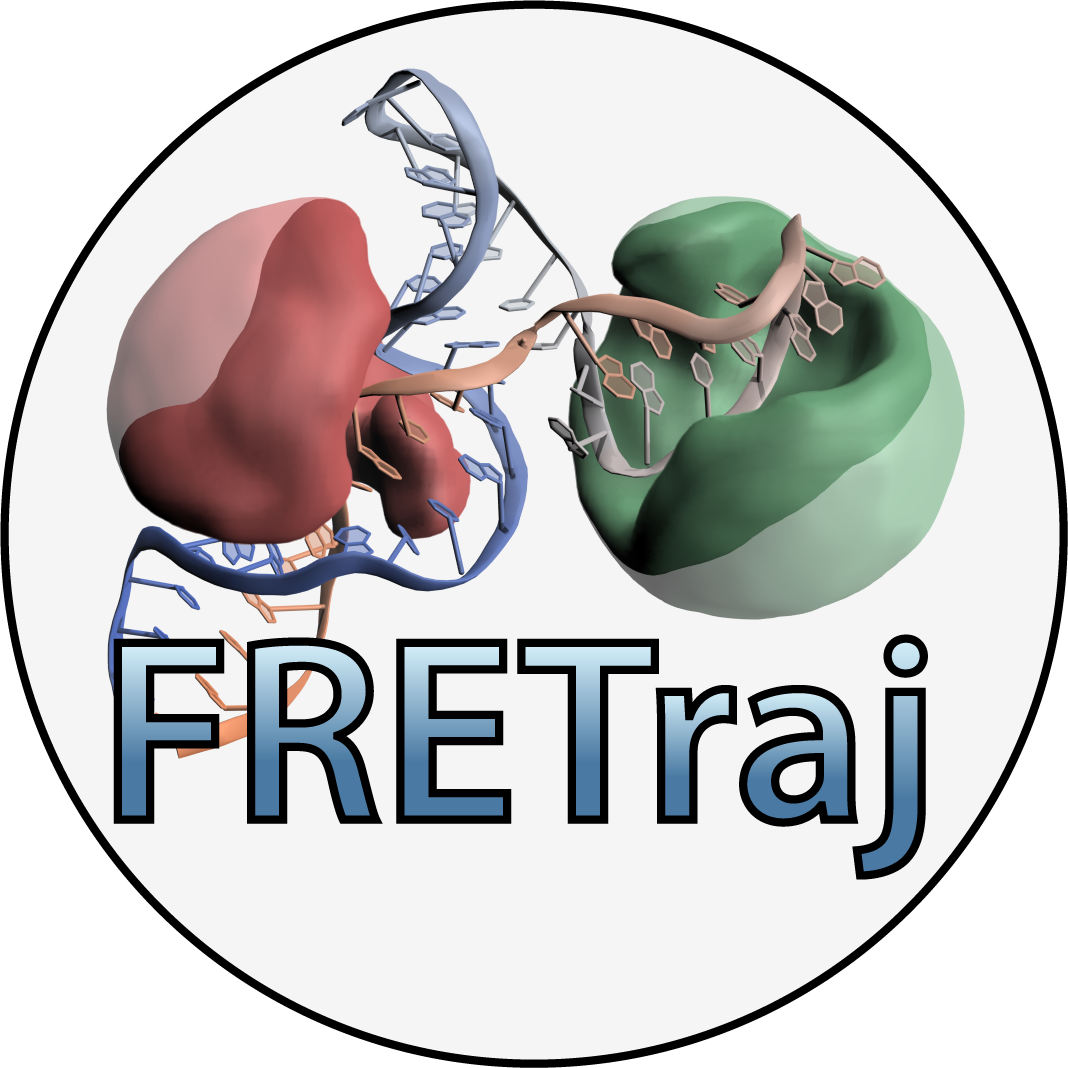Introducing FRET restraints#
import numpy as np
from matplotlib import pyplot as plt
import pandas as pd
import mdtraj as md
import fretraj as ft
import importlib
Accessible contact volume#
Calculate ACVs for donor and acceptor dye on an solvated and energy minimized biomolecule.
Note: the generated .gro file must first be converted to a .pdb file using
gmx trjconv
labels = ft.cloud.labeling_params('gmx/mn_riboswitch_labels.json', verbose=False)
struct = md.load_pdb('gmx/mn_riboswitch.pdb')
struct_nosolv = struct.remove_solvent()
don = ft.cloud.Volume(struct_nosolv, '1-B-U1-O5\'', labels)
acc = ft.cloud.Volume(struct_nosolv, '1-A-A1-O5\'', labels)
Compute a FRET trajectory from the ACVs
fret_traj = ft.cloud.FRET(don, acc, 'A1-U1', labels)
fret_traj.values
| R0 (A) | <R_DA> (A) | <E_DA> | <R_DA_E> (A) | R_attach (A) | R_mp (A) | |
|---|---|---|---|---|---|---|
| value | 54.0 | 96.1 | 0.04 | 91.9 | 86.6 | 94.4 |
| std | NaN | 10.7 | 0.03 | 13.0 | NaN | NaN |
Create a Plumed object from the loaded structure and the ACVs. Look for neighboring phosphorus atoms within a range of 15 A.
plumed = ft.restraints.Plumed(struct_nosolv, [don, acc], selection='name P', cutoff=15)
Set your desired FRET value that you want the simulation converge to. The corresponding \(\langle R_{DA,E}\rangle\) will be computed from the \(\langle E\rangle\). The \(\langle R_{mp}\rangle\) will be calculated from \(\langle E\rangle\) using a third order polynomial (Kalinin et al., Nat. Methods, 2012)
targetFRET = 0.6
mean_R_DA_E = ft.fret.mean_dist_DA_fromFRET(None,None,targetFRET,54)
targetRmp = ft.fret.R_DAE_to_Rmp(mean_R_DA_E)
Compile a plumed input file for the MD simulation
plumed.write_plumed('gmx/out/plumed_A1-U1.dat', targetRmp, 100, 100)
True
To illustrate the restaints save a visualization script for VMD or PyMOL which can be run with either vmd_vis -c filename.gro -x trajectory.xtc -v vis.vmd or pymol_vis -c filename.gro -x trajectory.xtc -v vis.py
plumed.write_vmd('gmx/out/vis.vmd')
plumed.write_pymol('gmx/out/vis.py')
Save force field and topology files files of the mean position pseudoatoms
plumed.write_pseudo('gmx/out/MP.pdb', 'gmx/out/MP.itp')
(1) Copy the "MP.itp" file into your force field directory
(2) Add the following lines to your "topology.top" file:
; Include topology for dye mean position
#include "<path/to/forcefield>/MP.itp"
#ifdef POSRES
[ position_restraints ]
1 1 1000 1000 1000
#endif
(3) Add the following line to your "atomtypes.atp" file in the force field directory:
MP 0.00000 ;
(4) Add the following lines to your "ffnonbonded.itp" file in the force field directory:
; Dummy mass for dye mean position
MP 35 79.90 0.0000 A 4.64693e-01 2.45414e-01
don.save_mp('gmx/out/mn_riboswitch_D.dat', units='nm', format='plain')
acc.save_mp('gmx/out/mn_riboswitch_A.dat', units='nm', format='plain')
First, backup the original .gro file. Then, insert the mean position coordinates given in MP.pdb at positions specified by riboswitch_D.dat and riboswitch_A.dat
mv em/mn_riboswitch.gro em/mn_riboswitch_original.gro
gmx insert-molecules -ci MP.pdb -f mn_riboswitch_original.gro -o mn_riboswitch.gro -ip out/mn_riboswitch_D.dat -replace water |& tee tmp_insert.dat
gmx insert-molecules -ci MP.pdb -f mn_riboswitch.gro -o mn_riboswitch.gro -ip out/mn_riboswitch_A.dat -replace water |& tee -a tmp_insert.dat
Run the following command will tell you how many solvent molecules have been replaced by the MP pseudoatoms and how to update the topology.
awk '$1 == "Replaced" {sum += $2}; END {print "\nIn your topology.top file under the section [ molecules ] do the following:\n(1) decrease the number of solvent molecules by " sum "\n(2) add the following line:\nMP 2"}' tmp_insert.dat && rm tmp_insert.dat

